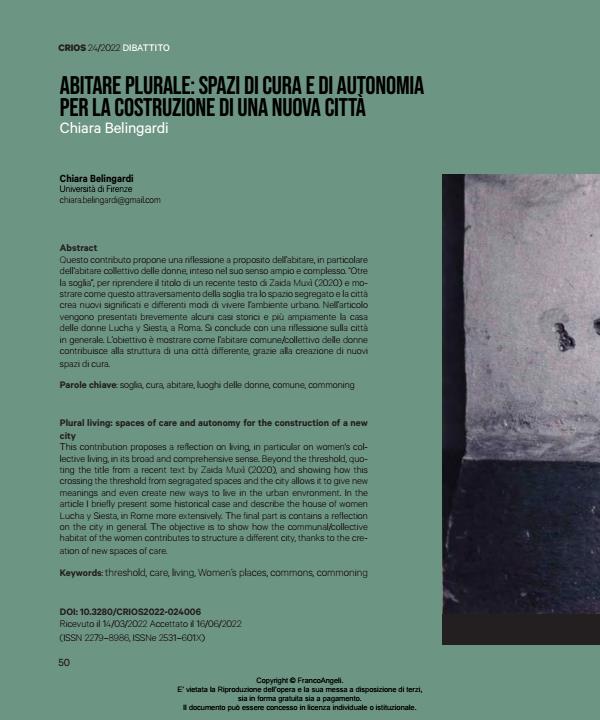Plural living: spaces of care and autonomy for the construction of a new city
Journal title CRIOS
Author/s Chiara Belingardi
Publishing Year 2024 Issue 2022/24 Language Italian
Pages 8 P. 50-57 File size 439 KB
DOI 10.3280/CRIOS2022-024006
DOI is like a bar code for intellectual property: to have more infomation
click here
Below, you can see the article first page
If you want to buy this article in PDF format, you can do it, following the instructions to buy download credits

FrancoAngeli is member of Publishers International Linking Association, Inc (PILA), a not-for-profit association which run the CrossRef service enabling links to and from online scholarly content.
This contribution proposes a reflection on living, in particular on women's collective living, in its broad and comprehensive sense. Beyond the threshold, quoting the title from a recent text by Zaida Muxì (2020), and showing how this crossing the threshold from segragated spaces and the city allows it to give new meanings and even create new ways to live in the urban envronment. In the article I briefly present some historical case and describe the house of women Lucha y Siesta, in Rome more extensively. The final part is contains a reflection on the city in general. The objective is to show how the communal/collective habitat of the women contributes to structure a different city, thanks to the creation of new spaces of care.
Keywords: threshold, care, living, Women’s places, commons, commoning
- Akbulut B. (2017). Carework as Commons: Toward a Feminist Degrowth Agenda. Resilience. (disponibile online) -- https:// www.resilience.org/stories/2017-02-02/carework-as-com- mons-towards-a-feminist-degrowth-agenda/ [accesso 17/03/2023]
- Andreola F., Muzzonigro A. (2021). Milano Atlante di genere. Siracusa: LetteraVentidue.
- Bassanini G. (1992). La donna: architetture visibili e invisibili. Dalla casa d’altri alle stanze femmine. In Farè I. (a cura di) Il discorso dei luoghi. Genesi e avventure dell’ordine moderno. Napoli: Liguori.
- Bassanini G. (2008). Per amore della città. Donne, partecipazione, progetto. Milano: FrancoAngeli.
- Belingardi C., Mattogno C. (2019). Making Room and Occupying Space. Women Conquering and Designing Urban Spaces. The Plan Journal 4 (2): 371-390.
- Broccolini A. (2010). La città delle donne: esclusione, flanerie e diversità. In Barbieri P. (a cura di) È successo qualcosa alla città. Manuale di antropologia urbana. Roma: Donzelli.
- Care Collective (2021). Il manifesto della cura. Verona: Ombre Corte.
- Crova B. (1952). L’abitazione nei suoi riflessi sociali. Roma: Istituto di medicina sociale.
- Federici S. (2018). Reicantare il mondo. Femminismo e politica dei commons. Verona: Ombre corte.
- Federici S. (2020). Il punto zero della rivoluzione. Lavoro domestico, riproduzione e lotta femminista. Verona: Ombre corte.
- Fragnito M., Tola M. (a cura di) (2021). Ecologie della cura. Prospettive transfemministe. Napoli-Salerno: Orthothes Editrice.
- Friedan B. (1963). La mistica della femminilità. Milano: Edizioni di Comunità.
- Gabauer A., Knierbein S., Cohen N., Lebuhn H., Trogal K., Viderman T., Haas T. (a cura di) (2022). Care and the city. Encounters with Urban Studies. London-New York: Routledge.
- Grossi P. (1977). Un altro modo di possedere. L’emersione di forme alternative di proprietà alla coscienza giuridica post-unitaria. Milano: Giuffrè.
- Hayden D. (1981). The Grand Domestic Revolution: A History of Feminist Designs for American Homes, Neighborhoods, and Cities. Cambridge: MIT Press.
- Kern L. (2021). La città femminista. Roma: Treccani.
Chiara Belingardi, Abitare plurale: spazi di cura e di autonomia per la costruzione di una nuova città in "CRIOS" 24/2022, pp 50-57, DOI: 10.3280/CRIOS2022-024006